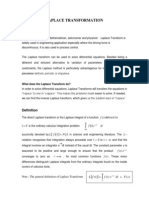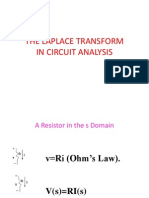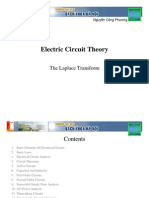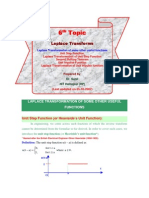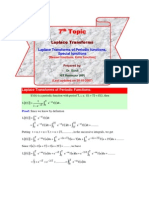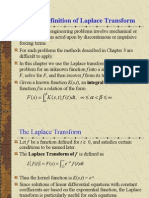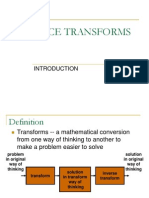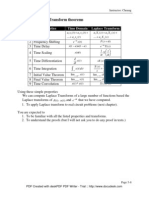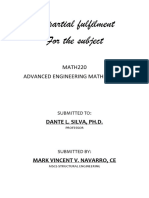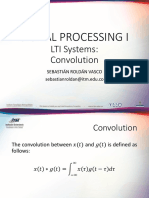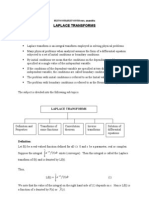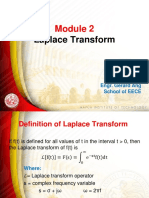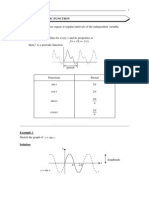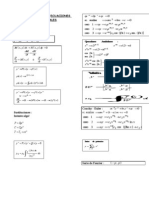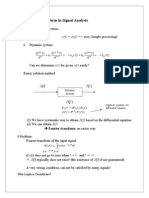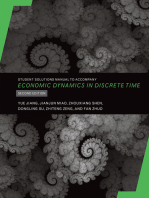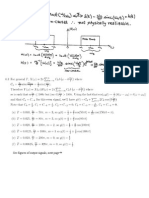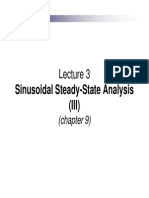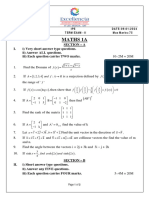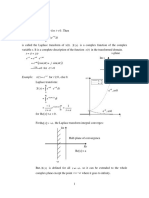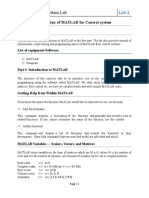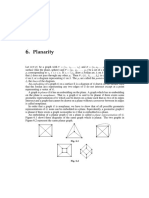Introduction To The Laplace Transform Transform: (Chapter 12)
Introduction To The Laplace Transform Transform: (Chapter 12)
Uploaded by
Phan Phuong NgocCopyright:
Available Formats
Introduction To The Laplace Transform Transform: (Chapter 12)
Introduction To The Laplace Transform Transform: (Chapter 12)
Uploaded by
Phan Phuong NgocOriginal Title
Copyright
Available Formats
Share this document
Did you find this document useful?
Is this content inappropriate?
Copyright:
Available Formats
Introduction To The Laplace Transform Transform: (Chapter 12)
Introduction To The Laplace Transform Transform: (Chapter 12)
Uploaded by
Phan Phuong NgocCopyright:
Available Formats
Lecture 6
Introduction To The Laplace
Transform Transform
(chapter 12)
Learning goals
Be able to calculate the Laplace Transform using
Definition of LT
The LT table and/or a table of operational transform
Be able to calculate inverse LT using partial fraction Be able to calculate inverse LT using partial fraction
expansion and the LT table
Understand and known how to use the initial value
theorem and the final value theorem
Why Laplace Transform?
- Laplace transform converts ordinary differential equations
into algebraic equations which are much simpler to solve.
This helps in easily examining transient behavior of the
multiple-node & multiple-mesh circuits
- To determine the transient response of a circuit (whose
signal sources vary in complicated ways), which phasor signal sources vary in complicated ways), which phasor
cannot provide.
- The difficulties are usually finding the inverse Laplace
transform.
as a Laplace-transform pair ( ) ( ) f t F s
Laplace Transform
{ {{ { } }} }
0
( ) ( ) ( )
st
f t F s f t e dt
L
S: Laplace transformation variable, unit of 1/s .
- f(t) for t<0 is irrelevant. This defines a unilateral or one-
side Laplace transform --> F(s) is determined by the
The LT of a function is given by the expression:
behavior of f(t) only for positive values of t
- Lower limit of the integration is zero. 0
-
is to remind to
include the origin.
If f(t) is continuous at
origin -> obvious solution
If f(t) is discontinuous at
origin, we choose 0
-
as the
lower limit
Step Function
The step function is a useful primitive for describing
transient event
Definition:
for 0 K t > >> >
K
( ) u t
If K=1, the function defined as the unit step
for
for
for
0
( ) 0.5 0
0 0
K t
Ku t K t
t
> >> >
= = = = = = = =
< << <
K
0
0.5K
t
can be viewed as limiting case of as ( ) ( ) 0 u t u t
0
( ) lim ( ) u t u t
=
( ) u t
Step Function
The step function is not defined at t=0, thus
1
( ) u t
0
x
0.5
1
( ) 0.5
2
0
t
t
u t t
t
> > > >
= + < < = + < < = + < < = + < <
< < < <
for
for -
for
Step Function/Delay by a
A discontinuity may occur at other times than t=0 (like
sequential switching), ex. if the signal delay by a, then
for 1 t a > >> >
1
for
for
for
1
( ) 0.5
0
t a
u t a t a
t a
> >> >
= = = = = = = =
< << <
0 a
t
Step Function: Applications
4
( ) f t
More complex functions
can be decomposed into a
series (sum) of unit step
Example:
( ) 2 ( ) 2 ( 2) ( 4)
( 6) ( 8) ( 10)
f t u t u t u t
u t u t u t
= + = + = + = +
2 4 6 8 10
2
series (sum) of unit step
Answer:
10
20
( ) f t
Find f(t)=?
Step Function: Applications
Example:
5 10
10 Find f(t)=?
[ [[ [ ] ]] ]
[ [[ [ ] ]] ]
( ) 2 ;5 10
( ) 2 ( 5) ( 10)
f t t t
f t t u t u t
= < < = < < = < < = < <
= = = =
Answer:
LT of Step Function
Laplace transform of a step function:
{ {{ { } }} }
0
( ) ( ) ( ) 1 0
1 1
1
st
st st
u t u t e dt u t t
e dt e
= = < < = = < < = = < < = = < <
= = = = = = = = = = = =
L
Thus obtain the Laplace transform pair:
0
0
1 e dt e
s s
= = = = = = = = = = = =
1
( ) u t
s
Impulse Function
- The concept of an impulse function enables us to define the
derivative at a discontinuity.
- Impulse signal dont exist in nature, but some circuit signals
come close to. It can be thought of as a derivative of a step
function
- Need to find out mathematical model of an impulse signal - Need to find out mathematical model of an impulse signal
-
Observation
As 0, f(t) between approaches a unit impulse function
An impulse function is created from a variable-parameter
(VP) function that exhibits the following three characteristics:
o The amplitude approaches infinity
o The duration of the function approaches zero
o The area under the VP function is constant when the
parameters changes
Impulse Function
As 0, f(t) K (t)
Impulse Function
0 0
( ) 0
0 0
t
t t
t
> >> >
= = = = = = = =
< << <
for
for
for
with condition that ( ) 1 t dt
= == =
0
t
with condition that ( ) 1 t dt
= == =
0
t
( ) t
1
2
can be viewed as a limiting case of as ( ) ( ) 0 t t
the area of
0
( ) lim ( )
( ) 1
t t
t
= == =
= == =
Sifting Property
Sifting or sampling property of the impulse function is
expressed as:
the impulse function
samples at
( ) ( ) ( )
( )
f t t a dt f a
f t t a
= = = =
= == =
proof: use the construction of
0
( ) lim ( ) t t
= == =
0
0
( ) ( ) lim ( ) ( )
lim ( ) ( )
( ) ( )
( )
a
a
a
a
f t t a dt f t t a dt
f t t a dt
f a t a dt
f a
+ + + +
+ + + +
= = = =
= = = =
= = = =
= == =
0
lim ( ) ( )
a
a
f t f a
+ + + +
= == =
evaluate
(as f(t) is continuous at a)
Example
15
5
15
5
( ) ( 18) ?
( ) ( 6) ?
f t t dt
f t t dt
= = = =
= = = =
5
15
5
15
5
( ) ( 18) 0
( ) ( 6) (6)
f t t dt
f t t dt f
= = = =
= = = =
Answer
LT Of The Impulse Function
Now, using the sifting property of the impulse function to
find its Laplace transform
Select
{ {{ { } }} }
0
0 0
( ) ( ) ( )
st st
t t e dt t e dt
+ ++ +
= = = = = = = =
L
Laplace transform pair
{ {{ { } }} }
and
0
( ) (0) 1
( ) 1 (0)
st
f t e f e
t f
= = = = = = = = = = = =
= = = = = = = = L
( ) 1 t
Impulse Function
How about Laplace transform of ?
'
( ) t
{ {{ { } }} }
0
'
2 2
0
0
1 1
( ) lim
st st
t e dt e dt
+ ++ +
( ( ( (
= + = + = + = +
( ( ( (
L
'
'
lim ( ) 0
( ) ( )
lim lim
lim ( ) 0 ( ) ( )
using L'Hopital rule:
or
or
x c
x c x c
x c
f x
f x f x
g x g x g x
=
`
=
)
Impulse Function
{ {{ { } }} }
( (( ( ) )) )
0
'
2 2
0 0
2
0
2
2
0
1 1
( ) lim
1
lim 1 1
( ) 2 0 0 2
lim
( ) 0 0
st st
s s
s s s s
t e dt e dt
e e
s
f e e e e
s
g s
+ ++ +
( ( ( (
= = = =
( ( ( (
= + + = + + = + + = + +
= + = = + = = + = = + = + + + +
= == =
= = = = = = = =
L
'
'
0
( ) 0 0
lim
2
( ) 2
s s s s
f se se se se
s
g s
= = = = = = = =
= == =
= = = =
'' 2 2 2 2 2
''
0
0
( ) 2 0
lim
2
( ) 2 0
s s s s
f s e s e s s e s e
s
g s
s
= + = = + = = + = = + = + ++ +
= == =
= = = =
= == =
{ {{ { } }} }
and
also note that
( )
( )
( )
n n
t s
du t
t
dt
= == =
= == =
L
Explain why the following function generates an impulse
function as 0
Problem 12.8
Explain why the following function generates an impulse
function as 0
Answer
Functional Transform
Exponential: { {{ { } }} }
0
( )
0
( )
0
1
at at st
a s t
s a t
e e e dt
e dt
e
s a
+ + + +
+ + + +
= == =
= == =
= = = =
+ ++ +
L
Laplace transform pair:
0
1 1
0
s a
s a s a
+ ++ +
= + = = + = = + = = + =
+ + + + + + + +
1
at
e
s a
+ ++ +
Fact: Integration across the discontinuity at the origin is zero
Functional Transform
Cosine:
{ {{ { } }} }
( (( ( ) )) )
0
cos( ) cos( )
1
cos
2
st
j t j t
t t e dt
t e e
= == =
( ( ( (
= + = + = + = +
( ( ( (
L
( (( ( ) )) )
( (( ( ) )) )
0
( ) ( )
0
( ) ( )
0
2
1
2
1
2
1 1 1
2
j t j t st
s j t s j t
s j t s j t
e e e dt
e e dt
e e
s j s j
+ + + +
+ + + +
= + = + = + = +
= + = + = + = +
| | | | | | | |
= = = =
| | | |
+ + + +
\ \ \ \
Functional Transform
Cosine: { {{ { } }} }
( (( ( ) )) )
0
cos( ) cos( )
1
cos
2
st
j t j t
t t e dt
t e e
= == =
( ( ( (
= + = + = + = +
( ( ( (
L
Sine: check textbook Laplace transform pair
2 2
2 2
1 1 1 1
2 2
s j s j
s j s j s
s
s
| | | | | | | | + + + + + + + +
| | | | | | | |
= + = = + = = + = = + =
| | | | | | | |
+ + + + + + + +
\ \ \ \
\ \ \ \
+ ++ +
=
2 2
sin t
s
+ ++ +
Functional Transform
Ramp:
{ {{ { } }} }
0 0
( ) ( )
st st
r t r t e dt te dt
= = = = = = = =
L
udv uv vdu = = = =
( ) r t
Using integral by parts:
for
for
0
( )
0 0
t t
r t
t
> >> >
= == =
< << <
;
1
;
st
st
u t dv e dt
du t v e
s
= = = = = = = =
= = = = = = = =
{ {{ { } }} }
0
0
2
1
( )
1
st st
t
r t e e dt
s s
s
= + = + = + = +
= == =
L
( ) r t
t
Letting:
This yields:
Operational Transform
Multiply by a constant:
{ {{ { } }} }
{ {{ { } }} }
0
0
( ) ( ) ( )
( ) ( )
st
st
st
f t f t e dt F s
af t af t e dt
= = = = = = = =
= == =
= = = = = = = =
L
L
0
( ) ( )
st
a f t e dt aF s
= = = = = = = =
Addition/subtraction:
{ {{ { } }} } { {{ { } }} }
{ {{ { } }} } ( (( ( ) )) )
1 1 2 2
1 2 1 2
0
1 2 1 2
0 0
( ) ( ); ( ) ( )
( ) ( ) ( ) ( )
( ) ( ) ( ) ( )
st
st st
f t F s f t F s
f t f t f t f t e dt
f t e dt f t e dt F s F s
= = = = = = = =
= = = =
= = = = = = = =
L L
L
Operational Transform
Time shift:
{ {{ { } }} }
0
( ) ( )
( ) ( )
( )
st
st
f t a u t a
f t a u t a e dt
f t a e dt
= = = =
= = = =
L
( ) Need to insure
that the delay function
u t a
'
'
'
' '
' ( ) '
0
' '
0
( )
( )
( ) ( )
st
a
s t a
t
sa st sa
f t a e dt
let t t a dt dt
f t e dt
f t e e dt e F s
+ + + +
= == =
= = = =
= + = = + = = + = = + =
= = = = = = = =
that the delay function
actually starts at t a =
Operational Transform
Frequency shift
{ {{ { } }} }
0
( )
0
( ) ( )
( ) ( )
at at st
s a t
e f t e f t e dt
f t e dt F s a
+ + + +
= == =
= = + = = + = = + = = +
L
0
{ {{ { } }} }
( (( ( ) )) ) ( (( ( ) )) )
' '
0
'
' '
'
' ' '
0 0
( ) ( )
1 1
st
s s
t t
a a
f at f at e dt
dt
let t at dt adt dt
a
dt s
f t e f t e dt F
a a a a
= == =
= = = = = = = = = == =
| | | | | | | |
= = = = = = = = = = = =
| | | |
\ \ \ \
L
Scale change:
Operational Transform
Differentiation:
Integral by parts:
'
0
( ) ( )
st
d
f t f t e dt
dt
= == =
` ` ` `
) ) ) )
L
'
; ( )
; ( )
st
st
u e dv f t dt
du se dt v f t
= = = = = = = =
= = = = = = = =
Thus:
Also:
0 0
( ) ( )
0 (0 ) ( ) ( ) (0 )
st st
f t e f t se dt
f sF s sF s f
= + = + = + = +
= + = = + = = + = = + =
1 2 '
3 '' 1
( ) ( ) (0 ) (0 )
(0 ) ...... (0 )
n
n n n
n
n n
f t s F s s f s f
t
s f f
= = = =
` ` ` `
) ) ) )
L
Operational Transform
Example:
{ {{ { } }} }
cos ? t = == = L
Operational Transform
Example: { {{ { } }} }
cos ? t = == = L
1
cos sin
1
d
t t
dt
d
= = = =
Answer
Thus:
{ {{ { } }} }
2 2
1
cos sin
( ) sin ; ( ) ( ) (0 )
( ) , (0 ) 0
d
t t
dt
d
f t t f t sF s f
dt
sF s s f
s
= == =
` ` ` `
) ) ) )
= = = = = = = =
= = = = = = = =
+ ++ +
L L
{ {{ { } }} }
2 2 2 2
1
cos
s s
t
s s
= = = = = = = =
+ + + + + + + +
L
Operational Transform
Integration:
Rearrange the integral order. To integrate t first.
{ {{ { } }} }
0 0 0
( ) ( )
t t
st
f x dx f x dx e dt
( ( ( (
= == =
( ( ( (
L
Rearrange the integral order. To integrate t first.
This yields:
0 0
0
1
( ) ( )
1 ( )
( )
st sx
x t x x
sx
x
e dt f x dx f x e dx
s
F s
f x e dx
s s
= = = = = = = = = = = =
= == =
= = = =
= = = = = = = =
Operational Transform
Multiplication by time
{ {{ { } }} }
( (( ( ) )) )
0
0
( ) ( )
( )
st
st
tf t tf t e dt
d
f t e dt
ds
= == =
= = = =
L
( (( ( ) )) )
0
0
( )
( ) ( )
st
f t e dt
ds
d d
f t e dt F s
ds ds
= = = =
= = = = = = = =
Operational Transform
Example:
{ }
cos ? t t = Find L
Operational Transform
Example:
{ }
cos ? t t = Find L
{ {{ { } }} }
cos cos
st
t t t te dt
= == =
L
Answer
{ {{ { } }} }
not easy to integrate
0
cos cos
st
t t t te dt
= == =
L
{ {{ { } }} }
{ {{ { } }} }
( (( ( ) )) )
2 2
2 2
2 2 2
2 2
cos ( )
cos ( )
s
t F s
s
d d s s
t t F s
ds ds s
s
= = = = = = = =
+ ++ +
= = = = = = = = = = = =
+ ++ +
+ ++ +
L
L
Using:
Then:
Operational Transform
Similarly:
{ {{ { } }} }
2
?
at
t e
= == = L
Operational Transform
Similarly:
Using:
{ {{ { } }} }
2
?
at
t e
= == = L
{ {{ { } }} }
1
at
e
s a
= == =
+ ++ +
L
Therefore
{ {{ { } }} }
( (( ( ) )) )
{ {{ { } }} }
( (( ( ) )) ) ( (( ( ) )) )
2
2
2 3
1 1
1 2
at
at
d
te
ds s a
s a
d
t e
ds
s a s a
| | | | | | | |
= = = = = = = =
| | | |
+ ++ +
\ \ \ \ + ++ +
| | | | | | | |
| | | | = = = = = = = =
| | | |
+ + + + + + + +
\ \ \ \
L
L
Inverse Laplace Transform
Hard way:
Lumped circuit with linear elements will generally produce
{ {{ { } }} }
1
1
( ) ( ) ( )
2
j
st
j
f t F s F s e ds
j
+ ++ +
= = = = = = = =
L
After solve the circuits in s-domain (Laplace domain), we have
to convert solution back to time domain
Lumped circuit with linear elements will generally produce
currents and voltages whose Laplace transforms are rational
function of s:
Proper rational functions have m>n
Easier approach: partial fraction expansion & table look up.
1
1 1 0
1
1 1 0
... ( )
( )
( ) ...
n n
n n
m m
m m
a s a s a s a N s
F s
D s b s b s b s b
+ + + + + + + + + + + + + + + +
= = = = = = = =
+ + + + + + + + + + + + + + + +
Inverse Laplace Transform
Four cases:
1. Distinct real roots
2. Repeated real roots
3. Distinct complex roots 3. Distinct complex roots
4. Repeated complex roots
Inverse Laplace Transform
N(s) has less degree than that of D(s), then the partial
fraction expansion is:
Heavisides Theorem:
Inverse Laplace Transform
If K
i
is known, we can find the inverse transform of each
term as
Step 1: factor the denominator polynomial
roots are all real and distinct
2
6 26 26
( ) 1, 2, 3
( 1)( 2)( 3)
s s
F s s
s s s
+ + + + + + + +
= = = = = = = =
+ + + + + + + + + + + +
Inverse Laplace Transform
Partial expansion will result in the following:
roots are all real and distinct
( 1)( 2)( 3) s s s + + + + + + + + + + + +
3 1 2
( )
1 2 3
K K K
F s
s s s
= + + = + + = + + = + +
+ + + + + + + + + + + +
If K1, K2, K3 can be found, then use transform pair:
1
( )
at
e u t
s a
+ ++ +
Inverse Laplace Transform
Sum all terms to find f(t):
s a + ++ +
2
1 2 3
1 2 3
6 26 26
( )
( 1)( 2)( 3)
t t t
s s
K e K e K e u t
s s s
+ + + + + + + +
( ( ( (
= + + = + + = + + = + +
` ` ` `
+ + + + + + + + + + + +
) ) ) )
L
To find ,multiply both sides by and set
1
( 1) 1 K s s + = + = + = + =
( 1) ( 1)
( 1) ( )
s s
s F s K K K
+ + + + + + + +
+ + + + + + + + + + + + =
Step 2: solve K1, K2 and K3
Inverse Laplace Transform
This yields
1 2 3
1
1
1
( 1) ( )
( 2) ( 3)
1 ( 1) ( )
s
s
s F s K K K
s s
s K s F s
= = = =
= = = =
+ + + + + + + + + + + +
+ + + + + + + +
= = = = = + = + = + = +
=
2
1
1
1
6 26 26
( 1) ( )
( 2)( 3)
6 26 26
3
1 2
s
s
s s
s F s K
s s
= = = =
= = = =
+ + + + + + + +
+ = + = + = + =
+ + + + + + + +
+ + + +
= = = = = = = =
=
To find ,multiply both sides by and set
2
( 2) 2 K s s + = + = + = + =
2
2
2
6 26 26
( 2) ( ) 2
( 1)( 3)
s
s s
s F s K
s s
= = = =
+ + + + + + + +
+ = = + = = + = = + = =
+ + + + + + + +
=
Inverse Laplace Transform
2
2
2
( 2) ( ) 2
( 1)( 3)
s
s
s F s K
s s
= = = =
= = = =
+ = = + = = + = = + = =
+ + + + + + + +
=
3
( 3) 3 To find ,multiply both sides by and set K s s + =
2
3
3
3
6 26 26
( 3) ( ) 1
( 1)( 2)
s
s
s s
s F s K
s s
= = = =
= = = =
+ + + + + + + +
+ = = + = = + = = + = =
+ + + + + + + +
=
Thus:
Using the Laplace transform pair:
3 2 1
( )
( 1) ( 2) ( 3)
F s
s s s
= + + = + + = + + = + +
+ + + + + + + + + + + +
Inverse Laplace Transform
Using the Laplace transform pair:
This yields,
2 3
( ) 3 2 ( )
t t t
f t e e e u t
( ( ( (
= + + = + + = + + = + +
1
at
e
s a
+ ++ +
Inverse Laplace Transform
Inverse Laplace Transform
1i
Inverse Laplace Transform
Inverse Laplace Transform
Inverse Laplace Transform
Inverse Laplace Transform
Inverse Laplace Transform
Inverse Laplace Transform
Inverse Laplace Transform
Inverse Laplace Transform
Inverse Laplace Transform
Improper Rational Function
An improper rational function can always be expanded
into a polynomial plus a proper rational function
Inverse Laplace Transform
Example:
Inverse Laplace Transform
a)
b)
c)
Poles and Zeros of F(s)
The transfer function of a circuit will have the form
1 2
1 2
( )( ) .......... ( )
( )
( )( ) .......... ( )
n
n
K s Z s Z s Z
F s
s P s P s P
+ + +
=
+ + +
Locations of poles and zeros will
make analysis of system response
and stability easier
The initial- and final-value theorems allow us to predict the
initial and final values of f(t) at 0 and from an s-domain
Initial- and Final-Value Theorem
0
0
lim ( ) lim ( )
lim ( ) lim ( )
Initial value:
Final value:
t s
t s
f t sF s
f t sF s
=
=
initial and final values of f(t) at 0 and from an s-domain
expression
- The initial-value theorem is based on the ass. That f(t)
contains no impulse functions
- The final-value theorem is valid only if the poles of F(s),
except for a first-order pole at the origin, lie in the left half of
the s plane
Initial- and Final-Value Theorem
( )
0 0
lim lim 0; 1
st st
df df
e dt dt t e
+ +
= = =
0
0
0 0
lim ( ) (0 ) lim
lim lim
st
s s
st st
s s
s
df
sF s f e dt
dt
df df
e dt e dt
dt dt
+
+
(
= +
=
Take the limit as
lim ( ) (0 ) (0 ) (0 )
lim ( ) (0 ) (0 ) (0 )
s
s
sF s f f f
sF s f f f
+
( =
=
Therefore: initial value lim ( ) (0 )
s
sF s f
+
=
( )
( )
0 0
0
lim lim 0; 1
lim ; 0 0
st st
s s
st st
s
df df
e dt dt t e
dt dt
df
e dt s e t
dt
+
= = =
for
Initial- and Final-Value Theorem
0
( ) (0 )
0
Final value:
Take the limit as
st
df
sF s f e dt
dt
s
lim ( ) (0 ) lim
st
df df
sF s f e dt dt
( =
=
0 0 0 0
lim ( ) (0 ) lim
st
s s
df df
sF s f e dt dt
dt dt
( =
=
0
0
lim ( ) (0 ) ( ) (0 )
lim ( ) ( ) Final value
s
s
sF s f f f
sF s f
( =
=
Initial- and Final-Value Theorem
Example:
What is Inverse Laplace transform of F(s)?:
2
7 63 134
( )
( 3)( 4)( 5)
s s
F s
s s s
+ +
=
+ + +
3 4 5
( ) 4 ( ) 6 ( ) 3 ( )
t t t
f t e u t e u t e u t
= +
Initial value:
Final value:
2
(7 63 134)
(0) 4
lim ( ) lim 7
( 3)( 4)( 5
6 3 7
)
s s
s s s
sF s
s
f
s s
+ + + + + + + +
= = = = = = = =
+ ++ +
= + = + = + = +
+ ++ +
= == =
+ ++ +
2
0 0
(7 63 134)
lim ( ) lim 0
( 3)( 4)( 5)
( ) 0
s s
s s s
sF s
s s s
f
+ +
= =
+ + +
=
Answer
You might also like
- CST 370 Final ExamDocument7 pagesCST 370 Final ExamJosh JonesNo ratings yet
- Ch4.Laplace Transform and Circuit AnalysisDocument61 pagesCh4.Laplace Transform and Circuit AnalysisamirNo ratings yet
- Laplace TransformationDocument7 pagesLaplace TransformationnualdinNo ratings yet
- Ee602 Circuit AnalysisDocument77 pagesEe602 Circuit AnalysisArryshah Dahmia100% (1)
- Chapter-2 Laplace Transform: Definition of The Laplace TransformationDocument15 pagesChapter-2 Laplace Transform: Definition of The Laplace Transformationnandakishore.nallaNo ratings yet
- Peretmuan 12 Laplace in CircuitsDocument56 pagesPeretmuan 12 Laplace in CircuitsSando CrisiasaNo ratings yet
- Chapter 7 4Document22 pagesChapter 7 4Muhd RzwanNo ratings yet
- 6 LTMDocument32 pages6 LTMyjartesnNo ratings yet
- Unit-VII Laplace Transforms: Properties of Laplace Transforms: L. Linearity Property: IfDocument21 pagesUnit-VII Laplace Transforms: Properties of Laplace Transforms: L. Linearity Property: IfRanjan NayakNo ratings yet
- Laplace TransformDocument10 pagesLaplace Transformariana_kardiamouNo ratings yet
- Aec AssignmentDocument14 pagesAec AssignmentAchyuta PatroNo ratings yet
- 03 - The Laplace TransformDocument54 pages03 - The Laplace TransformHandi RizkinugrahaNo ratings yet
- Transform A Dala PlaceDocument28 pagesTransform A Dala PlaceGino MasciottiNo ratings yet
- ECE 6345 ECE 6345: Notes 10Document18 pagesECE 6345 ECE 6345: Notes 10msh-666No ratings yet
- Dr. Mohammed Gulam AhamadDocument37 pagesDr. Mohammed Gulam AhamadMohammad Gulam AhamadNo ratings yet
- LTM Laplace Transform 2011a MKDocument94 pagesLTM Laplace Transform 2011a MKNguyen Manh LongNo ratings yet
- Bab V Transformasi Laplace: DT T F e T F LDocument14 pagesBab V Transformasi Laplace: DT T F e T F LKisworo DiniantoroNo ratings yet
- 6 6 6 6 Topic Topic Topic Topic: Laplace Transforms Laplace Transforms Laplace Transforms Laplace TransformsDocument23 pages6 6 6 6 Topic Topic Topic Topic: Laplace Transforms Laplace Transforms Laplace Transforms Laplace TransformsManpreet SinghNo ratings yet
- Lapplace TransformDocument22 pagesLapplace TransformAnthony KwoNo ratings yet
- 7 7 7 7 Topic Topic Topic Topic: Laplace Transforms Laplace Transforms Laplace Transforms Laplace TransformsDocument10 pages7 7 7 7 Topic Topic Topic Topic: Laplace Transforms Laplace Transforms Laplace Transforms Laplace TransformsManpreet SinghNo ratings yet
- LaplaceDocument19 pagesLaplaceBlackArmy88No ratings yet
- CH 6.1: Definition of Laplace Transform: DT T F T S K S FDocument13 pagesCH 6.1: Definition of Laplace Transform: DT T F T S K S FkhamruddinNo ratings yet
- Laplace Transforms1Document110 pagesLaplace Transforms1nileshsawNo ratings yet
- Chapter 3 - MatlabDocument59 pagesChapter 3 - MatlabZe SaNo ratings yet
- VAR Models: Gloria González-RiveraDocument32 pagesVAR Models: Gloria González-RiveraVinko ZaninovićNo ratings yet
- تحكم اليDocument6 pagesتحكم اليmahmoud zntaneNo ratings yet
- Enae 641Document17 pagesEnae 641bob3173No ratings yet
- LaplaceDocument42 pagesLaplaceAseel OtoumNo ratings yet
- 5-3. Some Laplace Transform TheoremsDocument6 pages5-3. Some Laplace Transform TheoremsMai-mai CantigaNo ratings yet
- Notes LT3Document12 pagesNotes LT3veteron56No ratings yet
- Math3 Lecture03Document11 pagesMath3 Lecture03Munif MubtasimNo ratings yet
- Mark Vincent Navarro - AssignmentDocument11 pagesMark Vincent Navarro - AssignmentMARK VINCENT NAVARRONo ratings yet
- EL-4701 Modelos de Sistemas: FormularioDocument9 pagesEL-4701 Modelos de Sistemas: FormularioEmmanuel AcostaNo ratings yet
- Lecture 13 MMP-IIDocument4 pagesLecture 13 MMP-IISharmeen IqrazNo ratings yet
- Laplace TransformDocument28 pagesLaplace Transformsjo05No ratings yet
- Session 8 - LTI Systems (III) - ConvolutionDocument17 pagesSession 8 - LTI Systems (III) - ConvolutionDaniela GiraldoNo ratings yet
- The Z TransformDocument23 pagesThe Z TransformIzzat AzmanNo ratings yet
- LAPLACE FormulaeDocument25 pagesLAPLACE FormulaeMalluri Veera BrahmamNo ratings yet
- Analisa FourierDocument17 pagesAnalisa FourierarrowzyNo ratings yet
- Laplace QuestionsDocument49 pagesLaplace QuestionsAmit Thakur100% (1)
- Advanced Engg Math Module 2Document12 pagesAdvanced Engg Math Module 2Joshua Roberto GrutaNo ratings yet
- 05 LaplaceTableDocument2 pages05 LaplaceTableAmo Amor AmornNo ratings yet
- Applications of Laplace Transform Unit Step Functions and Dirac Delta FunctionsDocument8 pagesApplications of Laplace Transform Unit Step Functions and Dirac Delta FunctionsJASH MATHEWNo ratings yet
- Free Ebooks DownloadDocument31 pagesFree Ebooks DownloadedholecomNo ratings yet
- Periodic Function: T F L T FDocument29 pagesPeriodic Function: T F L T FDavid WhiteNo ratings yet
- Formula Rio EDDocument3 pagesFormula Rio EDrolando_gzaNo ratings yet
- The Laplace Transform in Signal Analysis: X (F) Y (F)Document12 pagesThe Laplace Transform in Signal Analysis: X (F) Y (F)s_arunmozhiNo ratings yet
- 2009 2 Art 04Document8 pages2009 2 Art 04Raja RamNo ratings yet
- Lecture 3. Continuous Time System Analysis UsingLaplace TransformDocument44 pagesLecture 3. Continuous Time System Analysis UsingLaplace TransformTayner KgosienngweNo ratings yet
- DC AnalysisDocument27 pagesDC AnalysisJr CallangaNo ratings yet
- Lecture 2 - Laplace TransformsDocument24 pagesLecture 2 - Laplace Transformsbayan.life14No ratings yet
- 446-05 Laplace II (N) - HandoutDocument8 pages446-05 Laplace II (N) - HandoutIrfan MahyunisNo ratings yet
- The Spectral Theory of Toeplitz Operators. (AM-99), Volume 99From EverandThe Spectral Theory of Toeplitz Operators. (AM-99), Volume 99No ratings yet
- Student Solutions Manual to Accompany Economic Dynamics in Discrete Time, second editionFrom EverandStudent Solutions Manual to Accompany Economic Dynamics in Discrete Time, second editionRating: 4.5 out of 5 stars4.5/5 (2)
- Green's Function Estimates for Lattice Schrödinger Operators and ApplicationsFrom EverandGreen's Function Estimates for Lattice Schrödinger Operators and ApplicationsNo ratings yet
- Differentiation (Calculus) Mathematics Question BankFrom EverandDifferentiation (Calculus) Mathematics Question BankRating: 4 out of 5 stars4/5 (1)
- Lec5 OpAmp PDFDocument63 pagesLec5 OpAmp PDFPhan Phuong NgocNo ratings yet
- Practice Final1 EE235Document9 pagesPractice Final1 EE235Phan Phuong NgocNo ratings yet
- EE-235 Summer 2011 Signals & Systems Leo LamDocument6 pagesEE-235 Summer 2011 Signals & Systems Leo LamPhan Phuong NgocNo ratings yet
- EE235 - CH 1-2 PDFDocument35 pagesEE235 - CH 1-2 PDFPhan Phuong NgocNo ratings yet
- Lec7 FirstOrder 02 PDFDocument59 pagesLec7 FirstOrder 02 PDFPhan Phuong NgocNo ratings yet
- Lec6 - Mutual InductanceDocument30 pagesLec6 - Mutual InductancePhan Phuong NgocNo ratings yet
- Lec8 SecondOrder PDFDocument61 pagesLec8 SecondOrder PDFPhan Phuong NgocNo ratings yet
- Lec7 FirstOrder 01 PDFDocument60 pagesLec7 FirstOrder 01 PDFPhan Phuong NgocNo ratings yet
- Chapter 11 PDFDocument24 pagesChapter 11 PDFPhan Phuong NgocNo ratings yet
- Chapter 10 PDFDocument27 pagesChapter 10 PDFPhan Phuong NgocNo ratings yet
- Chapter 9 PDFDocument32 pagesChapter 9 PDFPhan Phuong NgocNo ratings yet
- Chapter 8 PDFDocument33 pagesChapter 8 PDFPhan Phuong NgocNo ratings yet
- Fundamentals of Electrical Engineering Electrical EngineeringDocument51 pagesFundamentals of Electrical Engineering Electrical EngineeringPhan Phuong NgocNo ratings yet
- Chapter 6 PDFDocument34 pagesChapter 6 PDFPhan Phuong NgocNo ratings yet
- Sinusoidal Steady-State Analysis (IV) (IV) : (Chapter 9)Document35 pagesSinusoidal Steady-State Analysis (IV) (IV) : (Chapter 9)Phan Phuong NgocNo ratings yet
- Sinusoidal Steady-State Analysis (III) (III) : (Chapter 9)Document49 pagesSinusoidal Steady-State Analysis (III) (III) : (Chapter 9)Phan Phuong NgocNo ratings yet
- Lec8 PDFDocument36 pagesLec8 PDFPhan Phuong NgocNo ratings yet
- Lec5 PDFDocument84 pagesLec5 PDFPhan Phuong NgocNo ratings yet
- Lec1 PDFDocument47 pagesLec1 PDFPhan Phuong NgocNo ratings yet
- Sinusoidal Steady-State Analysis (II) (II) : (Chapter 9)Document33 pagesSinusoidal Steady-State Analysis (II) (II) : (Chapter 9)Phan Phuong NgocNo ratings yet
- Engineering Mathematics 2 BEKG 2443: D ZiniDocument21 pagesEngineering Mathematics 2 BEKG 2443: D ZiniRashiqah RazlanNo ratings yet
- Halloween Activity CalculusDocument3 pagesHalloween Activity CalculusZ0mb13MCNo ratings yet
- JR Ipe Math 1a - 9-01-2024Document4 pagesJR Ipe Math 1a - 9-01-2024nats.stepanovnaNo ratings yet
- 2017-18 Who Are You Calling Math Face ProjectDocument7 pages2017-18 Who Are You Calling Math Face Projectapi-277216150No ratings yet
- ROSENDocument3 pagesROSENEleazar Jedaías NeriNo ratings yet
- 04 - Continuity and DifferentiabilityDocument8 pages04 - Continuity and DifferentiabilityRekha BhasinNo ratings yet
- 2019 Exam Papers With SolutionsDocument22 pages2019 Exam Papers With Solutionsrain wilsonNo ratings yet
- Assignment 1 Linear AlgebraDocument1 pageAssignment 1 Linear AlgebraAli GeeNo ratings yet
- Laplace TransformationDocument10 pagesLaplace TransformationAhasan UllaNo ratings yet
- IIITDM Kancheepuram: MAT204T: Linear AlgebraDocument2 pagesIIITDM Kancheepuram: MAT204T: Linear AlgebrayogaNo ratings yet
- Lecture-9 Unit-3 PMT-1803 Complex Analysis-I: Assistant Professor St. Xavier's College Ahmedabad, GujaratDocument12 pagesLecture-9 Unit-3 PMT-1803 Complex Analysis-I: Assistant Professor St. Xavier's College Ahmedabad, GujaratAryan ParmarNo ratings yet
- Linear-Programming-Group-8 20231211 115438 0000Document31 pagesLinear-Programming-Group-8 20231211 115438 0000Marivic BorbeNo ratings yet
- Domination in GraphsDocument6 pagesDomination in GraphsJunel Alapa100% (1)
- Lecture Notes On Functional Analysis-II by Dr. H. S. Mehta: Hahn-Banach TheoremDocument5 pagesLecture Notes On Functional Analysis-II by Dr. H. S. Mehta: Hahn-Banach Theoremblow mindNo ratings yet
- Linear Control System LabDocument18 pagesLinear Control System LabMuhammad Saad Abdullah100% (1)
- Q2b Route InspectionDocument33 pagesQ2b Route InspectionlaurenNo ratings yet
- Introduction To Trigonometry PYQS On Latest SyllabusDocument8 pagesIntroduction To Trigonometry PYQS On Latest SyllabusPATASHIMUL GRAM PACHAYATNo ratings yet
- Dual PDFDocument29 pagesDual PDFdangreglongNo ratings yet
- MSC Numerical 2007Document6 pagesMSC Numerical 2007Matthew FunnellNo ratings yet
- Presentation TFM Piecewise Non Autonomous Equations EnglishDocument38 pagesPresentation TFM Piecewise Non Autonomous Equations EnglishRobertoTFNo ratings yet
- Answer To Practice Exercise On Reimann SumDocument7 pagesAnswer To Practice Exercise On Reimann SumSofiaNo ratings yet
- Determinants - Level Module-6-ADocument13 pagesDeterminants - Level Module-6-ARaju SinghNo ratings yet
- l10 - Linear Algebra - Matrix SpacesDocument30 pagesl10 - Linear Algebra - Matrix SpacesHarshini MNo ratings yet
- Greedy Algorithms and Dynamic ProgrammingDocument45 pagesGreedy Algorithms and Dynamic ProgrammingIsabella IsaNo ratings yet
- The Rules of DifferentiationDocument6 pagesThe Rules of DifferentiationWhateverNo ratings yet
- Abstract AlgebraDocument4 pagesAbstract Algebradennis dancunNo ratings yet
- PM Shri KV Gachibowli Maths Class XII Sample Papers Answers For PracticeDocument178 pagesPM Shri KV Gachibowli Maths Class XII Sample Papers Answers For Practicejeeaspirant2024jaiNo ratings yet
- Write Matlab Code For Solving This BVP Using Finite Different MethodDocument4 pagesWrite Matlab Code For Solving This BVP Using Finite Different Methodhussein muhammadNo ratings yet
- Integration Formulae (HSC+Admission) by Kritti NathDocument4 pagesIntegration Formulae (HSC+Admission) by Kritti NathKritti NathNo ratings yet


